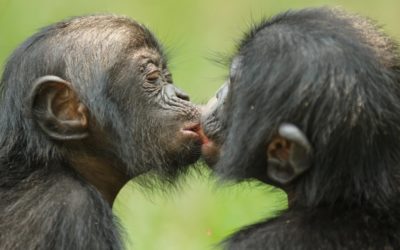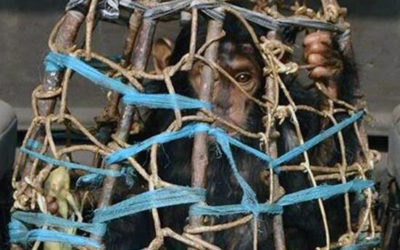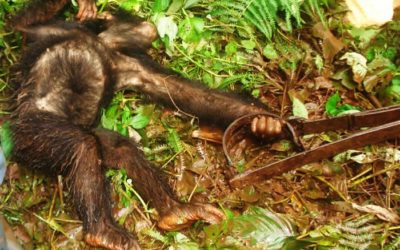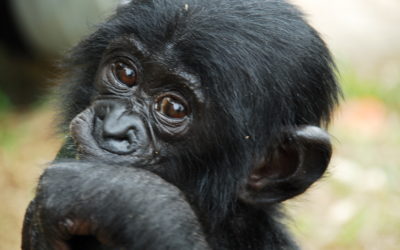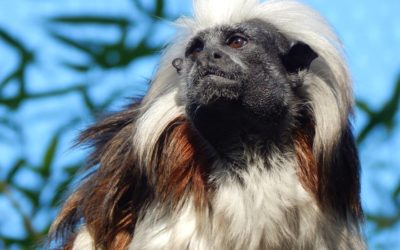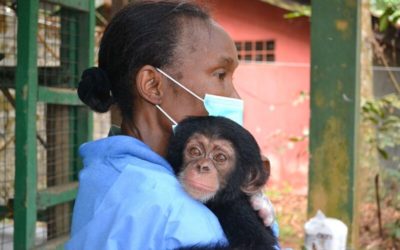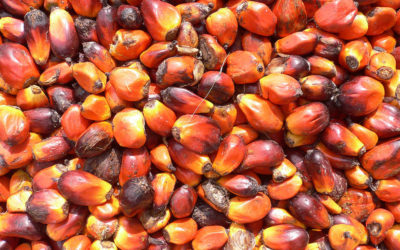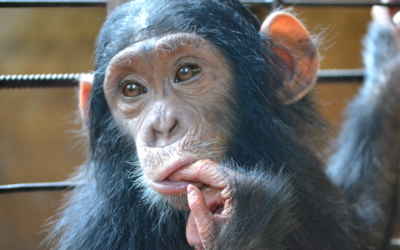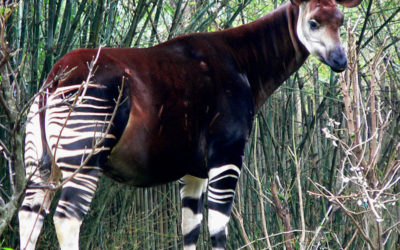We All Get By With a Little Help from Our Friends
It took a human to show Nina how to care for her new son.
By Natasha Tworoski
When humans prepare to have their first baby, it can be a nerve-wracking time filled with uncertainty. Fortunately, there are countless resources that help us prepare: classes, books, websites and most importantly, tips from family and friends. It turns out that there’s a learning curve for chimpanzees raising their first babies, too! A young chimp named Nina recently had to rely on a little help from her sanctuary caregivers to help her through this major life event.
In the wild, chimpanzee social groups are comprised of multiple males and females. Since the Jane Goodall Institute – South Africa’s Chimpanzee Sanctuary, also known as Chimp Eden, has already rescued as many orphaned chimpanzees as they have space for, allowing them to breed would eventually make the wildlife center pretty crowded. To prevent this, but also to allow the chimpanzees to live in normal social groups with males and females together, the female chimpanzees at the sanctuary receive a contraceptive implant – the same kind human women use!
Recently, one of the adult female chimpanzees, Nina, started displaying unusual behavior, such as drinking excessive water and having low energy. Suspecting kidney failure, the veterinarians anesthetized her to perform a physical examination. Feeling an abdominal lump, they had growing concerns that her issue could be a tumor. Fortunately, additional tests revealed the tumor was in fact a baby on the way! Like in humans, contraception is not a 100% guarantee of protection against pregnancy. At only 9 years old, Nina was also pretty young to be pregnant. Most wild chimpanzees won’t have their first baby until they are 12-15 years old.
Since Nina had grown up in a sanctuary where older females were not having babies, she hadn’t had opportunities to learn how to be a mother through observation. When her male infant, Thabu, arrived, Nina seemed confused and overwhelmed. She didn’t even know how to carry him properly, and she sometimes carried him upside down! Of most concern was that she didn’t breastfeed him during his first four days of life.
Staff at Chimp Eden immediately began trying different methods to teach Nina how breastfeeding works. This started with showing a video of a chimpanzee breastfeeding, Unfortunately, Nina showed more interest in wanting to play with the ipad than watching the video.
Next, using a chimpanzee toy, they demonstrated to Nina how to breastfeed, but it seemed to scare her more than anything, possibly her misinterpreting the stuffed toy as a dead animal. How could they teach Nina?
Finally, a woman who lived near the sanctuary that had a baby of her own came to demonstrate to Nina how to breastfeed an infant. It worked! After one look, Nina successfully began breastfeeding little Thabu. Once staff felt confident that both Nina and Thabu were healthy, they were reintroduced to their social group, where Thabu’s new family immediately showed adoration and affection for this lucky “accident.”
Thanks to Jana Swart of Chimp Eden for sharing this beautiful story with PASA and thanks to all the staff at Chimp Eden for what they do for chimpanzees, even when one comes as an extra surprise!
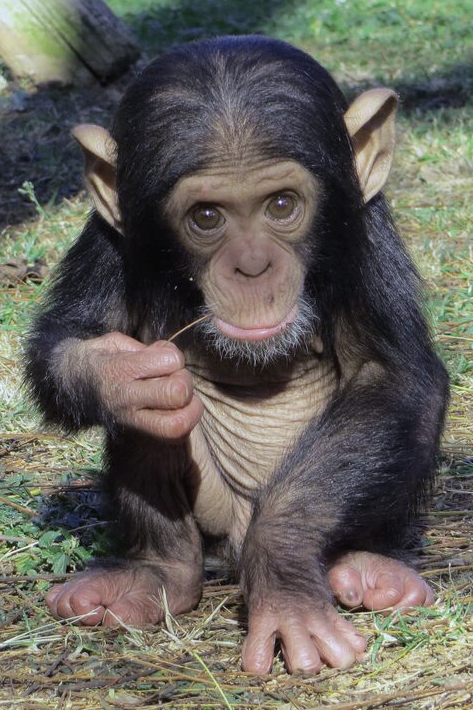
When Thabu was born, Nina didn’t know how to feed, care for or even carry him. She sometimes carried him upside down.
Once Thabu’s mother learned how to breastfeed, the infant thrived.

Next Posts
Celebrate the Unknown Great Ape on World Bonobo Day!
Celebrate the Unknown Great Ape on World Bonobo Day! Our closest relatives desperately need you to save them from extinction. There may only be 15,000 left. By Natasha Tworoski Finally! A reason for everyone, single or not, to celebrate February 14th! 2017 will mark...
How Can You Reduce Climate Change by Helping Protect Great Apes?
How Can You Reduce Climate Change by Helping Protect Great Apes? New Data Show that Climate Change Is Causing Massive Tree Die-Offs in Africa By Natasha Tworoski It’s hard to find a place on the planet where scientific evidence isn’t showing global climate change...
Groundbreaking Ivory Ban in China Signifies Good News for All Wildlife
Groundbreaking Ivory Ban in China Signifies Good News for All Wildlife Ban Includes Closure of 34 Processing Factories and 143 Trade Venues By Natasha Tworoski One of Africa’s most iconic animals, elephants have undergone a devastating surge in poaching in the past...
Bushmeat Crisis
Bushmeat Crisis In West Africa and the Congo Basin, Bushmeat is Now the Leading Threatto Great Apes and Monkeys By Natasha Tworoski While the term “bushmeat” can simply stand for any wild animal killed for the purpose of eating its meat, most often in media it is used...
Sanctuaries Unaffected by Political Unrest in Democratic Republic of Congo
Sanctuaries Unaffected by Political Unrestin Democratic Republic of Congo Tensions Remain High As At Least 26 Protesters Are Killed By Natasha Tworoski Tensions have been high this week in the Democratic Republic of Congo, as December 19th marked the end of President...
Empowering Women Through Conservation
Empowering Women Through Conservation Offering Opportunities for Women Is a Responsibility Conservationists Should Consider By Natasha Tworoski Conservation efforts can often carry a despairing feeling of moral conflict, particularly in countries with high levels of...
The Growing Crisis of Great Ape Smuggling
The Growing Crisis of Great Ape Smuggling New Data Shows that Illegal Great Ape Smuggling Is Even More Dire than We Realized By Natasha Tworoski The great ape crisis is rapidly escalating. Eastern gorillas, Western chimpanzees and Bornean orangutans were recently...
The Devastation of Palm Oil is Now Spreading to African Countries
The Devastation of Palm Oil is Now Spreading to African Countries By Natasha Tworoski The overwhelming demand for palm oil is well-known for its horrifying impact in eastern Asia, particularly in Malaysia and Indonesia. However, growing demand means...
Protecting Primates in the Democratic Republic of Congo
Protecting Primates in the Democratic Republic of Congo By Natasha Tworoski The Democratic Republic of Congo is home to three PASA sanctuaries: Lola ya Bonobo, JACK (Jeunes Animaux Confisques au Katanga) and the Centre de Rehabilitation des Primates de Lwiro (CRPL)....
Democratic Republic Of Congo: On the Brink of a New Wave of Violence?
Democratic Republic Of Congo: On the Brink of a New Wave of Violence? By Natasha Tworoski A country that has faced a long history of violence and political instability, the Democratic Republic of Congo (DRC) is teetering on the brink of a new wave of violence. As the...

